Did you know that in Japan there are two New Year holidays? Do you know how to wish a Happy New Year in japonês? Are you familiar with the traditions and customs? In this article, we will explore everything about the New Year's Eve and New Year in Japan called Oshougatsu [お正月].
New Year is the moment when families gather for a feast. The holiday is associated with food, festive decorations, rituals, observances, pastimes, and events that give the day a lot of flavor and charm.
Unlike Brazil, it's not a hellish noise with fireworks, drunkenness and mess. Japan truly celebrates the new year with traditions and meaning.
Table of Content
How is the new year celebrated in Japan?
The New Year in Japan is known as Oshougatsu [お正月] and is celebrated from January 1 to January 3, but some traditions extend until the end of January with festivals, performances, and ceremonies.
The New Year in Japan has been celebrated since 1873, when the country adopted the Gregorian calendar (previously it used the Chinese calendar).
Visiting temples in Japanese New Year
More than 100 million Japanese visit the Shinto shrine or Buddhist temple during the New Year to make a brief prayer at the shrine altar. The first visit of the year is known as hatsumoude [初詣].
Many light bonfires large or small to warm the crowds that are there. Incense is also burned at home or at shrines in the New Year. Incense smoke is considered a purification.

Ring the bell - Some Buddhist temples in Japan ring the bell 108 times at midnight to represent the 108 human sins of Buddhism. When this is done, visitors have a rare opportunity to ring the temple bell. This symbolizes the cleansing of sins.
Emma – These are prayer boards that are related to an old tradition of donating horses to shrines. It is popular to write your wishes for the coming year on an emu and leave it hanging in the shrine.
Hamaya - Literally meaning "Demon destroying arrow" are decorations with samurai origins that are sold at shrines during the new year. Children often receive this decoration in the form of an arrow.
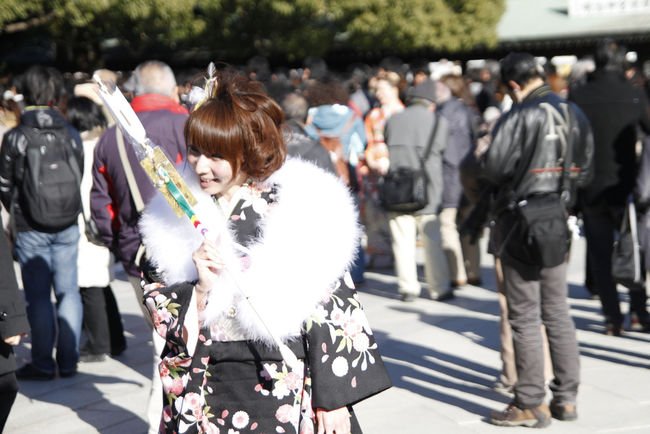
Omikuji - They are random fortunes written on slips of paper in Shinto and Buddhist temples in Japan. It is very common during the new year for the Japanese to get their luck.
Dondo Yaki - during the new year, Japanese get new lucky charms and objects. There is a bonfire where they can throw the old objects to burn, throwing them in the trash means bad luck.
Omamori - These are silk brocade lucky charms that have small pieces of paper or wood inside that have prayers written on them. There are thousands of different Omamori, for love, driving in traffic, pregnancy, etc.
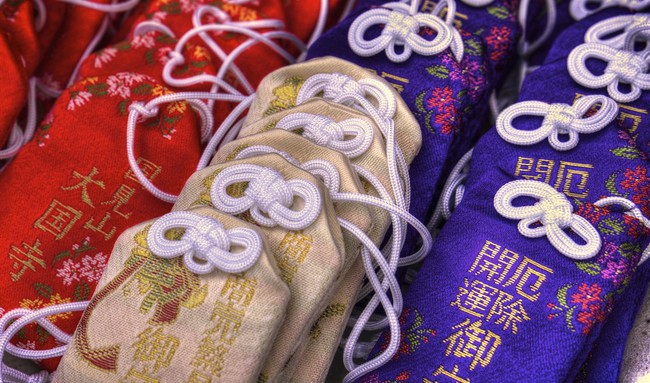
Other New Year's Traditions in Japan
Hatsuhinode - 初日の出 - On January 1st, the Japanese usually get up very early to watch the first dawn of the year. Many get together and go to the coast or some mountain to enjoy the sunrise. So many poems haiku it's about the first sunrise of the year.
Oniyouzu - During the New Year, Japanese people usually fly kites (or kites) made of paper. In the past, people flew kites known as Oniyouzu in the shape of Japanese demons, as a symbolic way of getting rid of evil. Today most fly normal kites.
Otoshidama - It is customary for parents, grandparents, aunts and uncles to give children money in special envelopes for the New Year. Depending on the age of the children this is usually between 3,000 to 10,000 yen.
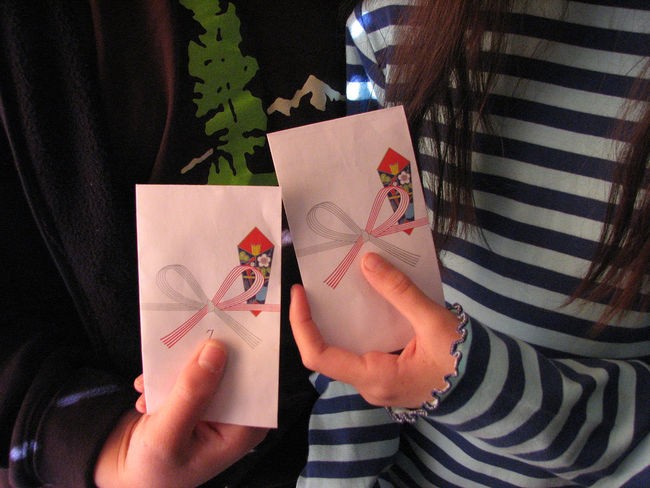
Kadomatsu – This is a bamboo decoration widely used in the Japanese New Year. They are placed in front of houses after Christmas until the 15th of January, then they are set on fire together with other New Year's decorations.
Kohaku Uta Gassen - A Japanese TV special that has been running for over 60 years. It is one of the most popular shows in the history of Japanese entertainment, which 80% of the Japanese population watches every year. It is a musical show with several performances and Japanese pop bands.
Nengajo – These are New Year's postcards. Every year Japan sends more than 3 billion postcards that arrive on January 1st.
old games - During the Japanese New Year, many ancient and traditional games are played. Children are taught by their grandparents to play old games like Karuta. Even in Kyoto there is a championship where participants dress up in kimono.
Fukubukuro - Literally means lucky bag. A Japanese tradition where during the New Year several stores sell mysterious bags containing different products inside.

New Year's Feast in Japan
Let's now look at some foods consumed during the New Year in Japan. Japanese people also usually gather with family and prepare some traditional dishes like kagami mochi, amakaze, toshikoshi soba, ozoni, otoso and others.
Osechi Ryori - There are at least 50 dishes associated with Japanese New Years that are collectively known as Osechi Ryori. Each dish has its own symbolic meaning for health, longevity, happiness and success.
Cooking Osechi Ryori is a difficult task because it is common to have 30 or more varieties of food for the New Year's meal. Some people usually order an obendo from the markets or konbini.
Mochi - Dumplings made from ground glutinous rice, it is one of the main ingredients of New Year's cuisine. During the new year it is traditional to make mochi manually using a pestle.
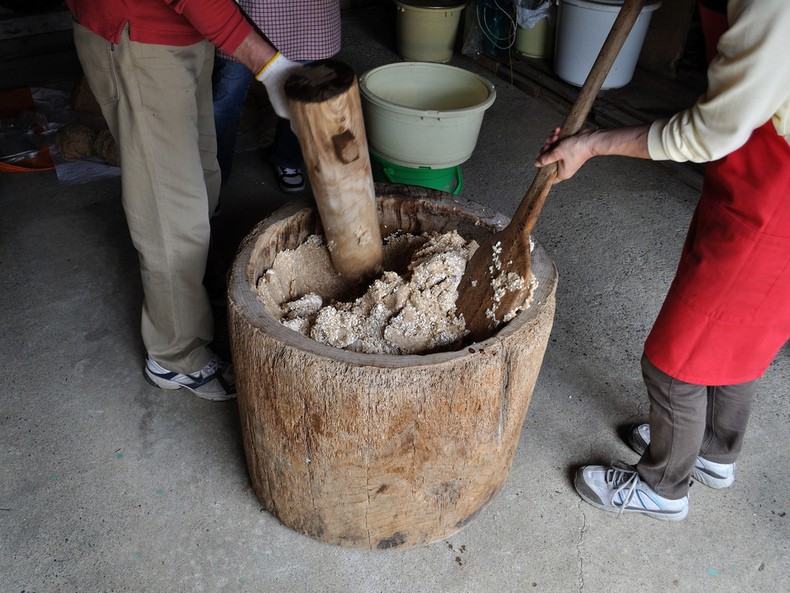
Kagami Mochi is one of the recipes made using mochi. They consist of two mochi with a daidai fruit on top. They are associated with longevity and are eaten in a ritual on the first weekend after the New Year.
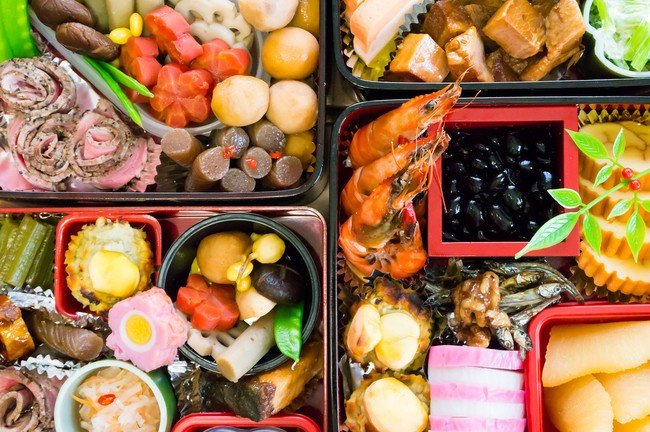
amaze - A traditional sweet drink made from fermented rice that is consumed hot in temples and shrines. Many shrines provide Amazake for free, others permitem that stalls sell.
Toshikoshi Soba – It is tradition on New Year's Eve to eat a bowl of buckwheat noodles known as Toshikoshi Soba just before midnight. The long shape of the noodles represents the passage from one year to the next.
The New Year is one of the busiest times, where thousands of people are traveling and enjoying their time off. There are several other traditions and events during the New Year. We have the emperor's greeting. In some places you can notice the release of fireworks, or balloons. There are numerous traditions that last until January 15th or more.
New Year phrases in Japanese
The best known, most formal and most complete way to say Happy New Year in Japanese is:
- Shin nen Akemashite omedetō gozaimasu
- 新年明けましておめでとうございます
This is the most complete form, usually shin nen [新年] which means new year is not used. Only akemashite [明けまして] is used, which comes from the verb akeru [明ける] and means to dawn, to be born, and to grow. The possible variations are:
- 明けましておめでとうございます
- 明けましておめでとう
- 明けておめでとう (akete omedetou);
- あけおめ (akeome);

The level of formality decreases more and more depending on how you abbreviate. If you are going to speak with strangers or colleagues, try to use at least akemashite omedetou gozaimasu.
It is uncommon to use the expressions that contain akemashite before the New Year starts, as the verb refers to something that has already happened. If you want to wish a happy New Year before the year ends, you can try other expressions like:
- よいお年をお迎えください。
- Yoi otoshi o omukae kudasai;
- short formHappy New Year!
Another common expression used is "kotoshimo yoroshiku onegaishimasu" [今年もよろしくお願いします], which means "I hope to count on your collaboration this year." Some young people shorten this phrase in casual occasions by saying koto yoro [ことよろ]!
In business cards, it is common to find written gashou [賀正], shoushun [頌春], and keishun [慶春], which also mean happy new year. It is not normal to say these words; they are just archaic forms found in New Year cards.
No matter how much I wrote about this years ago in the article about Frases de Ano novo em Japonês. I will finish the article by leaving a video of my friend Tarou Yamada talking about New Year's phrases in japonês:
